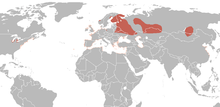Little gull
| Little gull | |
|---|---|
_a_(4834254958).jpg) | |
| Scientific classification | |
| Kingdom: | Animalia |
| Phylum: | Chordata |
| Class: | Aves |
| Order: | Charadriiformes |
| Family: | Laridae |
| Genus: | Hydrocoloeus Kaup, 1829 |
| Species: | H. minutus |
| Binomial name | |
| Hydrocoloeus minutus (Pallas, 1776, rivers of Siberia) | |
 | |
| Range of H. minutus | |
| Synonyms | |
|
Larus minutus Pallas, 1776 | |
The little gull (Hydrocoloeus minutus or Larus minutus), is a small gull that breeds in northern Europe and Asia. The genus name Hydrocoloeus is from Ancient Greek hudro, "water", and koloios, a sort of web-footed bird. The specific minutus is Latin for "small".[2]
It also has small colonies in parts of southern Canada. It is migratory, wintering on coasts in western Europe, the Mediterranean and (in small numbers) the northeast United States; in recent years non-breeding birds have summered in western Europe in increasing numbers and in 2016 they successfully nested for the first time in Great Britain at the Royal Society for the Protection of Birds reserve at Loch of Strathbeg reserve in Aberdeenshire.[3] As is the case with many gulls, it has traditionally been placed in the genus Larus. It is the only member of the genus Hydrocoloeus, although it has been suggested that Ross's gull also should be included in this genus.
This species breeds colonially on freshwater marshes, making a lined nest on the ground amongst vegetation. Normally 2–6 eggs are laid.
This is the smallest gull species, with a length of 25–30 cm (9.8–11.8 in), a wingspan of 61–78 cm (24–31 in), and a mass of 68–162 g (2.4–5.7 oz).[4][5][6] It is pale grey in breeding plumage with a black hood, dark underwings and often a pinkish flush on the breast. In winter, the head goes white apart from a darker cap and eye-spot. The bill is thin and black and the legs dark red. The flight on rounded wings is somewhat tern-like.
Young birds have black markings on the head and upperparts, and "W" pattern across the wings. They take three years to reach maturity.
These gulls pick food off the water surface, and will also catch insects in the air like a black tern.
Gallery
- Egg, Collection Museum Wiesbaden
 Adult in winter plumage
Adult in winter plumage Juvenile; Yyterin, Pori, Suomi - Finland
Juvenile; Yyterin, Pori, Suomi - Finland Adult Breeding plumage
Adult Breeding plumage Picking food from the water surface
Picking food from the water surface
References
- ↑ Butchart, S.; Symes, A. (2012). "Hydrocoloeus minutus". IUCN Red List of Threatened Species. IUCN. 2012: e.T22694469A38866773. Retrieved 30 April 2016.
- ↑ Jobling, James A (2010). The Helm Dictionary of Scientific Bird Names. London: Christopher Helm. pp. 196, 256. ISBN 978-1-4081-2501-4.
- ↑ "World's smallest gull breeding in Scotland for the first time". Rare Bird Alert. Retrieved 6 August 2017.
- ↑ Dunning, John B., Jr., ed. (1992). CRC Handbook of Avian Body Masses. CRC Press. ISBN 978-0-8493-4258-5.
- ↑ Little gull media at ARKive
- ↑ "Little gull". All About Birds. Cornell Lab of Ornithology.
External links
| Wikimedia Commons has media related to Hydrocoloeus minutus. |
| Wikispecies has information related to: Hydrocoloeus minutus |
- BirdLife species factsheet for Hydrocoloeus minutus
- "Hydrocoloeus minutus". Avibase.

- "Little gull media". Internet Bird Collection.
- Little gull photo gallery at VIREO (Drexel University)
- Interactive range map of Hydrocoloeus minutus at IUCN Red List maps
- Audio recordings of Little gull on Xeno-canto.
- Hydrocoloeus minutus in the Flickr: Field Guide Birds of the World
